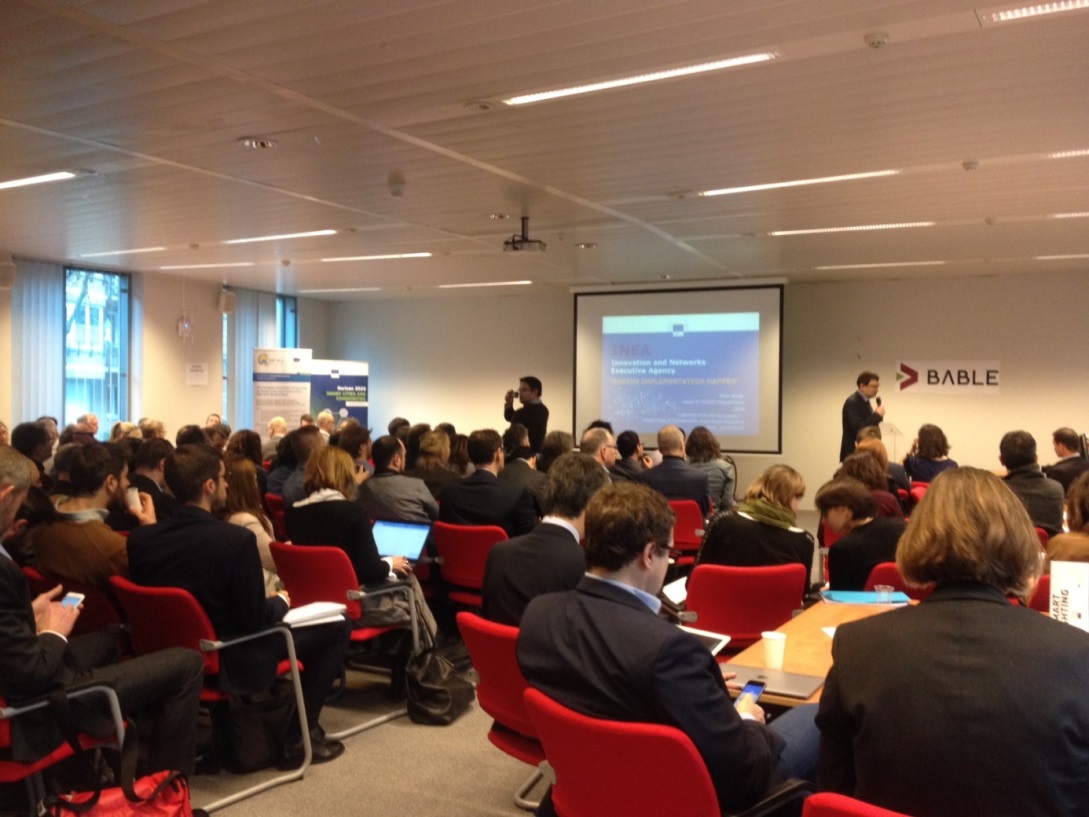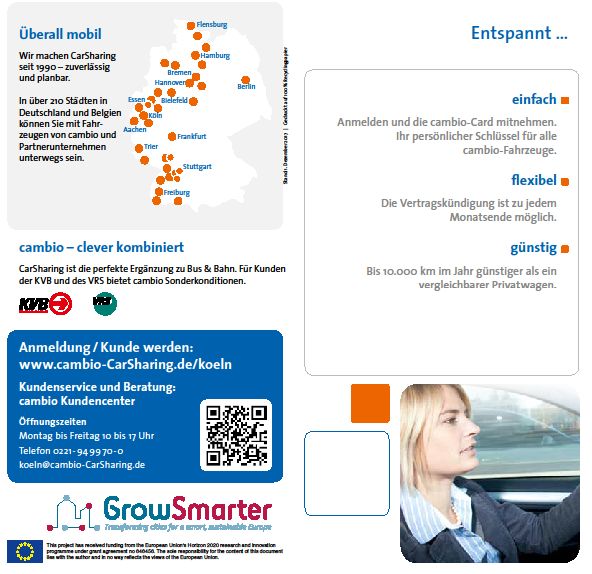Read about how Barcelona has completed refurbishment works in several building complexes, including social housing buildings, student residences, a new library and more! Energy saving solutions have been implemented together with smart monitoring systems to track the new energy performance of the buildings. The solutions being implemented could be replicated across the city and have a considerable impact on the energy performance of Barcelona's buildings.
Action area 1: Low-Energy Districts
To see all the measures to be implemented, click here.
Inaugural ceremony of newly retrofitted public library
The refurbishment works on the public library owned by Barcelona Municipality, which are part of the GrowSmarter project, have been completed. The inaugural ceremony of the Library Montserrat Abelló in the district Les Corts was held on 26th January with the attendance of the Mayor and other representatives of the City Council.
Located in an old silk factory, the new public library is an example of the refurbishment of an industrial building owned by the Municipality of Barcelona. In this case, three adjacent buildings (an old industrial building most recently used as a warehouse and two office buildings) have been retrofitted to become the new public library of the district, a public facility of more than 3,000 m2.
The new library is the first public building in the city of Barcelona with the BREEAM® (Building Research Establishment Environmental Assessment Methodology) certificate, a world-leading sustainability assessment method for buildings. In order to achieve this, the Municipality included energy efficiency criteria in the structural refurbishment of the building to reduce its environmental impact. The scope of the energy retrofitting works includes the improvement of the façade, roof, ground floor and glazing insulation to reduce the demand for heating and air conditioning of the building, the installation of radiant floor system for heating and cooling that contributes to the energy savings of the building, and the installation of software for the energy management of the building (BEMS). In addition, the library will cover part of its own electrical demand with a solar photovoltaic installation on the rooftop.
To watch a summary video of the inaugural ceremony please click here.
 The official speech held by the Administration during the inauguration ceremony. Source: Sergi Ramos/Diputació de Barcelona
The official speech held by the Administration during the inauguration ceremony. Source: Sergi Ramos/Diputació de Barcelona General view of the ground floor of the library. Source: IREC
General view of the ground floor of the library. Source: IRECWorks on social housing building finished by Barcelona Municipality
The refurbishment works in the residential building of Passeig Santa Coloma 55-71, promoted by the public body responsible for social housing in Barcelona Institut Municipal de l’Habitatge i la Rehabilitació - IMHAB , were finished in December 2017.
This building is composed of 207 dwellings with a total surface of 14,165m2, which will benefit from the passive refurbishment of the entire building façade. The insulation of the building façade is expected to lead to a reduction of the heating demand of the dwellings. The benefits for the tenants will not only be lower heating and energy bills, but also improved comfort and other qualitative aspects, such as noise and humidity insulation.
In order to assess the impact on user comfort, a survey and monitoring campaign was done in February 2017 as a baseline, and a second survey and monitoring campaign will now follow in February 2018, since the insulation works are now finished.

District heating connection between Melon District and DistrictClima
Melon District
Melon District Marina is the biggest student residence in Barcelona with more than 500 rooms. Melon District has a privileged location in the city thanks to its situation near the one of the most innovative neighbourhood in Barcelona, named 22@, as well as being just ten minutes walking from the centre of Barcelona.

Before the refurbishment, HVAC installations consisted of electric heaters that satisfied the heat demand and a connection to the nearest district heating and cooling (DH&C), named DistrictClima, for cooling in the summer and for domestic hot water.
Collaboration Agreement
At the outset of GrowSmarter, two buildings (not in Melon District) were under consideration for connection to the district heating network. However, after energy pre-analyses and a first contact with the communities were done, these buildings were deemed unsuitable for the project. Finally, after a long period of searching, Melon District was identified and its participation in the project was accepted by the property management in July 2016. The agreement was a private-private collaboration between Melon District property and Gas Natural Fenosa (GNF).
Before the agreement between the student residence and GNF, Melon District had already planned a refurbishment of its building, though the heating system was not part of its initial refurbishment plans. But thanks to the European subsidy (via GrowSmarter) and the participation of Gas Natural Fenosa as an Energy Services Company (ESCO), the expansion of the initial scope of the refurbishment project was made possible.
GrowSmarter measures in Melon District
The refurbishment works carried out in the framework of GrowSmarter include connecting the heating installation to the nearest DH&C (DistrictClima) and installing a building energy management system (BEMs).
Work on the building started in August 2016 and finished in March 2017. Specifically, the refurbishments in Melon District were based on:
- Connection to the DH&C: Before the refurbishment, the heating system in Melon District was based on electric heaters to supply the heat demand. After the refurbishment, all the electric heaters were disconnected and heat is instead provided DistrictClima. This connection to the district heating network, shown in the following pictures, allows to Melon District to considerably reduce its primary energy consumption thanks to replacing the use of electricity with the DH&C.

- Building Energy Management System (BEMS): A new Building Energy Management System (BEMS) was installed in Melon District, which will provide relevant information about the energy consumption of the building. The BEMS allows the property managers to understand the energy impact of the students' habits and reduce consumption through the application of new control strategies. Furthermore, the BEMS will help Gas Natural Fenosa to develop new strategies to better respond to disturbances or stresses in the system.
A Home Energy Management System (HEMS) was also installed on one floor (B4) of the Melon building, which monitors the energy use of the four bedrooms and one kitchen on the floor. Thanks to the data gathered here, Gas Natural Fenosa will be able to disaggregate total consumption measured by the BEMs by each room and kitchen in Melon District.
Together, these measures are expected to reduce the primary energy consumption of the building by 38%.
Added value
All the measures and works carried out in Melon District were part of an Energy Services contract, through which the Energy Services Company (ESCO) guarantees energy savings to Melon District as well as the correct operation of all installations for the stipulated period, in exchange of an annual fee.
Moreover, thanks to the Gas Natural Fenosa’s background and its large range of different clients, the project carried out in Melon District will be easily replicable beyond what has been demonstrated in GrowSmarter, multiplying the beneficial impacts of the project.
Last but not least, all data obtained by BEMS and HEMS will be fundamental to assessing the energy savings guarantees, thus improving the know-how of Gas Natural Fenosa and allowing Melon District to be more self-sufficient in its energy consumption.
Action area 2: Integrated Infrastructures
Action area 2: Integrated Infrastructures
To see all the measures to be implemented, click here.
Smart solution 8: Big data management
In Measure 8.2, we have added data access and query functionality beyond what GrowSmarter proposes. Concretely, we can now query and cross data from more than one source, in this case from the GrowSmarter API and from other triple stores containing Barcelona urbanistic data (where data is in RDF/OWL format). This is a first step towards integrating Linked (Open) Data.
Solution 3: Smart energy-saving tenants
Solution 6: Waste heat recovery
Solution 8: Big data management
 Gonzalo Cabeza
Gonzalo Cabeza
Site Manager, Barcelona
For the previous blog post, click here




 Poster announcing event
Poster announcing event Informational event for the tenants. Photo: Uta Konopka
Informational event for the tenants. Photo: Uta Konopka Informational event for the tenants. Photo: Uta Konopka
Informational event for the tenants. Photo: Uta Konopka Informational event for the tenants. Photo> Uta Konopka
Informational event for the tenants. Photo> Uta Konopka Study visit COP 23. Photo: Uta Konopka
Study visit COP 23. Photo: Uta Konopka THERMOS conference. Photo: Julia Egenolf
THERMOS conference. Photo: Julia Egenolf THERMOS conference. Photo: ICLEI
THERMOS conference. Photo: ICLEI SCC replication workshop. Photo: Julia Egenolf
SCC replication workshop. Photo: Julia Egenolf Photo: RheinEnergie AG
Photo: RheinEnergie AG Data fine dust collected from environmental sensors. Photo: City of Cologne
Data fine dust collected from environmental sensors. Photo: City of Cologne Model OpenAir Node Sensor Copyright City of Cologne
Model OpenAir Node Sensor Copyright City of Cologne Overview of Mobility Stations and partners involved
Overview of Mobility Stations and partners involved Jan-Wellem-Str, Copyright Ampido
Jan-Wellem-Str, Copyright Ampido Bergischer Ring, Copyright Ampido
Bergischer Ring, Copyright Ampido Montanusstrasse, Copyright Ampido
Montanusstrasse, Copyright Ampido Stegerwald neighborhood, Copyright Ampido
Stegerwald neighborhood, Copyright Ampido Multiticket
Multiticket Advertising flyer page 1
Advertising flyer page 1 Advertising flyer page 2
Advertising flyer page 2 Barbara Moehlendick
Barbara Moehlendick New interior window with u-value 0,6, the external window is original
New interior window with u-value 0,6, the external window is original The building with integrated solar panels on the southern side (upper right) of the external glass roof, all lights are LED-lights
The building with integrated solar panels on the southern side (upper right) of the external glass roof, all lights are LED-lights Vehicle sensor installed measuring in- and outcoming traffic in Slakthusarea
Vehicle sensor installed measuring in- and outcoming traffic in Slakthusarea Sign informing pedestrians and bicyclists of traffic flow measurements
Sign informing pedestrians and bicyclists of traffic flow measurements Mixed different coloured bags inside the container
Mixed different coloured bags inside the container  The Valla Torg Electrical Car Pool
The Valla Torg Electrical Car Pool Presenting GrowSmarter in Bratislava, Slovakia
Presenting GrowSmarter in Bratislava, Slovakia Mika Hakosalo
Mika Hakosalo